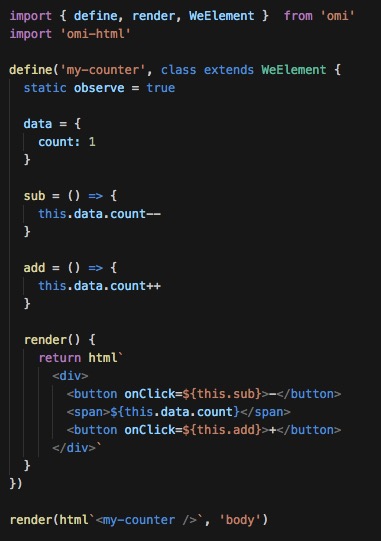`
- 标签自关闭: `
`
- 动态标签名: `<${tagName}>` _( `tagName` 是元素的引用)_
- 布尔属性: `
`
## 对 JSX 的改进
`htm` 确确实实地基于 JSX 之上做了大量改进,比如下面这些特性是 JSX 所没有的:
- **不需要编译器,直接在浏览器中运行**
- HTML 的可选分号的方式: `
`
- HTML 的自关闭: `

`
- 可选的关闭标签: `
this is the whole template!`
- 组件关闭标签: `<${Footer}>footer content`
- 支持 HTML 注释: `
`
- 安装 [lit-html VSCode extension] 语法高亮
## 项目状态
HTM最初的目标是在Preact周围创建一个包装器,使用它在浏览器中不受干扰。我想使用虚拟DOM,但我不想用构建工具,直接使用ES模块。
这意味着要放弃JSX,最接近的替代方案是 [Tagged templates]。所以,我写了这个库来修补两者之间的差异。事实证明,该技术是框架无关的,因此它应该与大多数虚拟 DOM 库一起工作。
## 安装
`htm` 发布到了 npm, 也可以访问 unpkg.com 的 CDN:
```js
npm i htm
```
**从unpkg获取:**
```js
import htm from 'https://unpkg.com/htm?module'
const html = htm.bind(React.createElement);
```
```js
// just want htm + preact in a single file? there's a highly-optimized version of that:
import { html, render } from 'https://unpkg.com/htm/preact/standalone.mjs'
```
## 使用指南
既然 `htm` 是一个通用的库,我们需要告诉它怎么“编译”我们的模板。
目标应该是形式 `h(tag, props, ...children)` _([hyperscript])_, 的函数,并且可以返回任何东西。
```js
// 这是我们的 h 函数。现在,它只返回一个描述对象。
function h(tag, props, ...children) {
return { tag, props, children };
}
```
为了使用那个 `h` 函数,我们需要通过绑定`htm`到我们的`h`函数来创建我们自己的 HTML 标签函数:
```js
import htm from 'htm';
const html = htm.bind(h);
```
现在我们有一个`html`模板标签,可以用来生成上面创建的格式的对象,比如:
```js
import htm from 'htm';
function h(tag, props, ...children) {
return { tag, props, children };
}
const html = htm.bind(h);
console.log( html`Hello world!
` );
// {
// tag: 'h1',
// props: { id: 'hello' },
// children: ['Hello world!']
// }
```
## 举个例子
好奇地想看看这一切是什么样子的?这是一个工作应用程序!
它是单个HTML文件,没有构建或工具。你可以用Nano编辑它。
```html
htm Demo
```
**这是一个[Preact 线上版本](https://htm-demo-preact.glitch.me/).**
那真是太好了?注意,只有一个导入-这里我们只使用了 `import` 与 Preact 集成,因为它更容易导入和更小。
同样的示例在没有预构建版本的情况下运行良好,只需使用两个导入:
```js
import { h, Component, render } from 'preact';
import htm from 'htm';
const html = htm.bind(h);
render(html`<${App} page="All" />`, document.body);
```
## 其他使用方式
因为`htm`被设计成满足JSX的相同需求,所以您可以使用JSX的任何地方使用它。
** 使用 [vhtml] 生成 HTML:**
```js
import htm from 'htm';
import vhtml from 'vhtml';
const html = htm.bind(vhtml);
console.log( html`Hello world!
` );
// 'Hello world!
'
```
**Webpack configuration via [jsxobj]:** ([details here](https://webpack.js.org/configuration/configuration-languages/#babel-and-jsx))
```js
import htm from 'htm';
import jsxobj from 'jsxobj';
const html = htm.bind(jsxobj);
console.log(html`
`);
// {
// watch: true,
// mode: 'production',
// entry: {
// path: 'src/index.js'
// }
// }
```
# omi-html
在 omi 中使用 [htm](https://github.com/developit/htm)
[→ 在线例子](https://tencent.github.io/omi/assets/omi-html.html)
## Usage of omi-html
```js
import { define, render, WeElement } from 'omi'
import 'omi-html'
define('my-counter', class extends WeElement {
static observe = true
data = {
count: 1
}
sub = () => {
this.data.count--
}
add = () => {
this.data.count++
}
render() {
return html`
${this.data.count}
`
}
})
render(html``, 'body')
```
## 直接运行在浏览器
```html
```
[Tagged Templates]: https://developer.mozilla.org/en-US/docs/Web/JavaScript/Reference/Template_literals#Tagged_templates
[lit-html]: https://github.com/Polymer/lit-html
[babel-plugin-htm]: https://www.npmjs.com/package/babel-plugin-htm
[lit-html VSCode extension]: https://marketplace.visualstudio.com/items?itemName=bierner.lit-html
[vhtml]: https://github.com/developit/vhtml
[jsxobj]: https://github.com/developit/jsxobj
[hyperscript]: https://github.com/hyperhype/hyperscript
 `
- 可选的关闭标签: `
`
- 可选的关闭标签: ` |
|  |
[`htm`](https://github.com/developit/htm) 全称是 Hyperscript Tagged Markup,是一款与 JSX 语法类似的东西,相比 JSX 它最大的优点是:
* 不需要编译器
* 直接在现代浏览器中运行,只要你的浏览器支持 [Tagged templates] 就行
所以,你可以直接在 react、preact 或者 omi 中使用并且直接在浏览器中运行,不需要任何编译。它利用了 [Tagged templates] 和浏览器自带的 HTML parser。
## 极小的尺寸
* 直接在浏览器中使用只有 700 字节,1KB 都不到
* 在 preact 中使用只有 500 字节
* 如果使用 [babel-plugin-htm](https://www.npmjs.com/package/babel-plugin-htm) 只需要 0 字节
## 语法 - 像 JSX 也像 lit-html
htm 是受 lit-html 启发,但是包含了 JSX 里的这些特性:
- 剩余扩展: `
|
[`htm`](https://github.com/developit/htm) 全称是 Hyperscript Tagged Markup,是一款与 JSX 语法类似的东西,相比 JSX 它最大的优点是:
* 不需要编译器
* 直接在现代浏览器中运行,只要你的浏览器支持 [Tagged templates] 就行
所以,你可以直接在 react、preact 或者 omi 中使用并且直接在浏览器中运行,不需要任何编译。它利用了 [Tagged templates] 和浏览器自带的 HTML parser。
## 极小的尺寸
* 直接在浏览器中使用只有 700 字节,1KB 都不到
* 在 preact 中使用只有 500 字节
* 如果使用 [babel-plugin-htm](https://www.npmjs.com/package/babel-plugin-htm) 只需要 0 字节
## 语法 - 像 JSX 也像 lit-html
htm 是受 lit-html 启发,但是包含了 JSX 里的这些特性:
- 剩余扩展: `